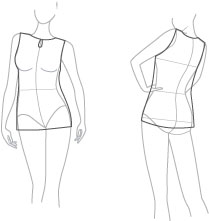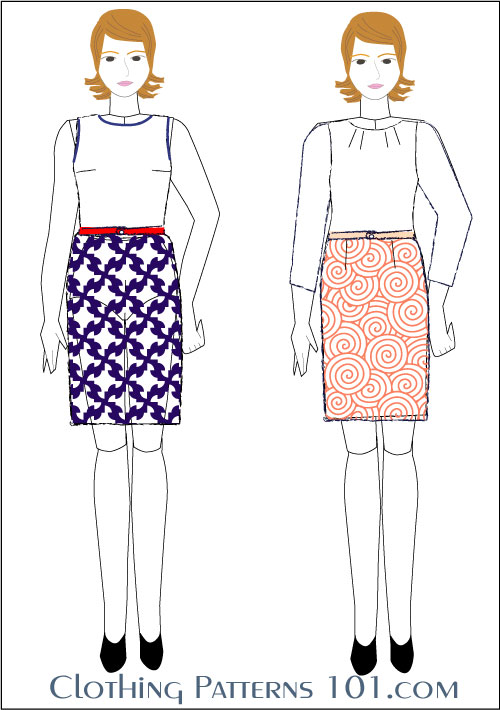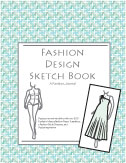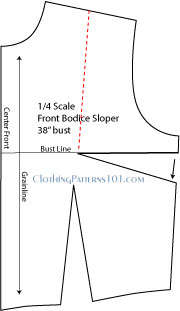- Clothing Patterns 101
- Finding Design Inspiration
- Sketch Your Design
How to Sketch Your Design
Once you've become inspired to create a new clothing style, there will be lots and lots of ideas swirling around in your head.
You see a sleeve you like on a dress, and a neckline you like on another dress. But you don't want a dress - you want a blouse!
How do you know if your ideas will work together?
Create a design sketch!
OK, So How Do I Do That?
|
Well, yeah, that seems like a good idea. But what if you're not a great artist? Your sketch may not really convey what you're trying to accomplish - and then what do you do? Use a croqui! A what??? A croqui is a nude body figure that you will "dress" in your design ideas. They can be found online (downloadable versions), or you can get a fashion sketchbook with a variety of figures. |
 |
Sketching on a croqui is almost like dressing a body form. You start with a a figure (with no clothing on it), and you add clothing, layer by layer.
The benefits of using a croqui rather than drawing free-hand are:
1 - you can draw with a natural proportion (the waist, hip, sleeve length, etc will always be in the right place)
2 - croquis usually have a front and back drawing, allowing you to design and illustrate details on the back, too
3 - most croquis are drawn with the figure in motion, allowing you to show the sway of a full skirt or the flare of an open jacket
You can easily create a professional - looking sketch, even if (like me) your drawings are usually stick figures!
Note - In the sketches below, notice that my sketch lines are much darker and thicker than the croqui itself - it's supposed to be that way! The croqui is just a form used to create an interesting design. The garment itself is the focal point, not the body figure.
Let me show you how.....
Let's say, I want to design a blouse. Not a tailored, button-front blouse that I might wear to the office, but something with a little more flair - something I could wear with a skirt or pants, tucked in or untucked. For a nice shopping trip or lunch with friends, for example.
 |
I start by sketching the overall shape of the blouse - not too close-fitting! This is not button-front, but it's not a casual knit, either. It has to fit over the head and hang freely. Sketch the shoulders, armhole, and sides first. Then - how long? Waist-length, high hip, hip length, top of thigh, tunic? Let's just do a standard hip length. Remember, we want to be able to tuck it in or leave it out - hip length is good for that. Add a line for the bottom hem. |
|
And what about neckline? This has to pull over the head, so it has to be somewhat open. I like a wide neckline. It's not as wide or high as a boatneck, but wider than the jewel neckline of a standard bodice block. (If you like a "clean" neckline in the front, that vent can be done at the back neck instead.) |
 |
 |
And the sleeves? I like a bell sleeve, and a sleeve with a long ruffle, added at 3/4 length, is a nice variation. This ruffle is circular, and would be drafted like a circle skirt. Use the forearm/bottom of the 3/4 length sleeve circumference as the "waist" of the skirt when drafting. |
Hey, Look!! We drew a blouse!
|
Remember when I referred to a neckline from one dress, a sleeve from another, but turning it into a blouse? That's what we just did! This is how you check your ideas to see if they work. I think this one works nicely (I finished off the sketch with color, and drawing simple pants to illustrate how the blouse could be worn). |
 |
But you might decide to change something - using a V-neck, for example. Or the same neckline and a different sleeve.
The beauty of using a croqui is that you can sketch over and over again, tweaking the length of the garment, the shape of the neckline, or the fullness of the sleeve ruffle as often as you like (use a pencil, of course, and you can make changes as you go along!).
Just keep sketching until you're happy with the result!
And remember - there's more to design than the silhouette. Add color - or pattern! - after you've finished the basic drawing. You'll be amazed at what you can create!
More on Design and Basic Pattern Making
Return to Clothing Patterns 101 Home Page
ClothingPatterns101.com does not sell the personal information of its users to anyone, ever.



